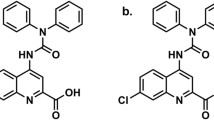Abstract
Several benzodiazepine receptor ligands were pharmacologically characterized in a battery of functional tests after oral administration in mice, rats, and monkeys. Previous experiments have consistently demonstrated that diazepam exhibits high intrinsic efficacy, bretazenil exhibits intermediate intrinsic efficacy, Ro 42-8773 and Ro 41-7812 both show low intrinsic efficacy, and flumazenil exhibits virtually zero intrinsic efficacy. In the test battery used here it appears that nearly full intrinsic efficacy is required for clear anterograde amnesia or rotarod impairment. In contrast, full protection in the pentetetrazol test was achieved with intermediate-to-high intrinsic efficacy and nearly full protection with lower intrinsic efficacy. In the audiogenic seizure test full anticonvulsant effects were produced with intrinsic efficacy ranging from low to high. Clear inhibition of punished operant responding was observed for all test compounds except for Ro 41-7812 and flumazenil, which exhibit the lowest intrinsic efficacies. All of the test compounds enhanced palatable food consumption, with even those having low intrinsic efficacy producing maximum effects approximating that of diazepam. By additionally taking into consideration the degree of receptor occupancy required to obtain pharmacological activity in each of the tests in this battery it is possible to order the compounds with respect to intrinsic efficacy: diazepam>bretazenil>Ro 42-8773>Ro 41-7812>flumazenil. The latter four compounds all exhibited a maximum antagonistic activity in tests involving reversal of meclonazepam- or flunitrazepam-induced central nervous system depression. Thus, using these tests appears to permit the accurate ordinal classification of benzodiazepine receptor ligands for intrinsic efficacy. This is considered important in view of the goal of optimal selection of novel compounds exhibiting only the minimum level of intrinsic efficacy necessary for a given therapeutic indication, thereby minimizing potential side effects.
Similar content being viewed by others
References
Brogden RN, Goa KL (1991) Flumazenil: a reappraisal of its pharmacological properties and therapeutic efficacy as a benzodiazepine antagonist. Drugs 42:1061–1089
Delini-Stula A (1991) Prospective use of partial benzodiazepine agonists in the treatment of schizophrenia. Biol Psychiatry 29:53S-54S
Facklam M, Schoch P, Bonetti EP, Jenck F, Martin JR, Moreau JL, Haefely WE (1992) Relationship between benzodiazepine receptor occupancy and functional effects in vivo of four ligands of differing intrinsic efficacies. J Pharmacol Exp Ther 261:1113–1121
Gardner CR (1988) Pharmacological profiles in vivo of benzodiazepine receptor ligands. Drug Dev Res 12:1–28
Goeders NE, Kuhar MJ (1985) Benzodiazepine receptor binding in vivo with3H-Ro 15-1788. Life Sci 377:345–355
Haefely W (1984) Pharmacological profile of two benzodiazepine partial agonists: Ro 16-6028 and Ro 17-1812. Clin Neuropharmacol 7 [Suppl. 1]:670–671
Haefely WE (1990) The GABAA-benzodiazepine receptor: biology and pharmacology. In: Burrows GD, Roth M, Noyes Jr R (eds) Handbook of anxiety: the neurobiology of anxiety, vol 3. Elsevier Amsterdam, pp 165–188
Haefely W, Martin JR, Schoch P (1990) Novel anxiolytics that act as partial agonists at benzodiazepine receptors. TIPS 11:252–256
Haefely W, Facklam M, Schoch P, Martin JR, Bonetti EP, Moreau JL, Jenck F, Richards JG (1992) Partial agonists of benzodiazepine receptors for the treatment of epilepsy, sleep, and anxiety disorders. In: Biggio G, Concas A, Costa E (eds) GABAergic synaptic transmission. Raven Press, New York, pp 379–394
Haigh JRM, Feely M (1988) Ro 16-6028, a benzodiazepine receptor partial agonist, does not exhibit anticonvulsant tolerance in mice. Eur J Pharmacol 147:283–285
Katschnig H, Merz WA, Nutzinger D, Alf C, Berger SP, Kutzer M (1989) Attackenweise Behandlung des Paniksyndroms mit dem partiellen Benzodiazepin-Agonisten Ro 16-6028: Resultate einer plazebo-kontrollierten Doppelblindstudie mit 24 Patienten. In: Saletu B (ed) Biologische Psychiatrie. Thieme, Stuttgart, pp 167–169
Martin JR, Pieri L, Bonetti EP, Schaffner R, Burkard WP, Cumin R, Haefely WE (1988) Ro 16-6028: a novel anxiolytic acting as a partial agonist at the benzodiazepine receptor. Pharmacopsychiatry 21:360–362
Martin JR, Kuwahara A, Horii I, Moreau JL, Jenck F, Sepinwall J, Haefely WE (1990) Evidence that the benzodiazepine receptor partial agonist Ro 16-6028 has minimal abuse and physical dependence liability. Soc Neurosci Abstr 16:1104
Merz WA (1991) Partial benzodiazepine agonists: New concepts in the treatment of panic disorder and schizophrenia. In: Racagni G, Brunello N, Fukuda T (eds) Biological psychiatry, vol 1. Elsevier, Amsterdam, pp 727–731
Mikkelsen M, Gulliksen G, Dam M, Vesterager A, Gram L, Schou C, Alving J (1990) Antiepileptic activity of flumazenil. Acta Neurol Scand 82 [Suppl]:42
Moreau JL, Jenck F, Pieri L, Schoch P, Martin JR, Haefely WE (1990) Physical dependence induced in DBA/2J mice by benzodiazepine receptor full agonists, but not by the partial agonist Ro 16-6028. Eur J Pharmacol 190:269–273
Moreau JL, Jenck F, Bonetti EP, Martin JR, Haefely WE (1991) Novel long-acting benzodiazepine receptor ligands Ro 41-7812 and Ro 42-8773: neurological and behavioral profile. Drug Dev Res 22:375–383
Pieri L, Hunkeler W, Jauch R, Merz WA, Roncari G, Timm U (1988) Ro 16-6028, a benzodiazepine receptor partial agonist. Drugs of the Future 13:730–735
Savic I, Widen L, Stone-Elander S (1991) Feasibility of reversing benzodiazepine tolerance with flumazenil. Lancet 337:133–137
Sellers EM, Busto U, Kaplan HL (1991) Clinical abuse liability of partial and full agonist benzodiazepines: a comparison of bretazenil, diazepam and alprazolam. In: Racagni G, Brunello N, Fukuda T (eds) Biological psychiatry, vol 1. Elsevier, Amsterdam, pp 709–712
Woods SW, Charney DS, Silver JM, Krystal JH, Heninger GR (1991) Behavioral, biochemical, and cardiovascular responses to the benzodiazepine receptor antagonist flumazenil in panic disorder. Psychiatry Res 36:115–127
Author information
Authors and Affiliations
Rights and permissions
About this article
Cite this article
Martin, J.R., Schoch, P., Jenck, F. et al. Pharmacological characterization of benzodiazepine receptor ligands with intrinsic efficacies ranging from high to zero. Psychopharmacology 111, 415–422 (1993). https://doi.org/10.1007/BF02253530
Received:
Revised:
Issue Date:
DOI: https://doi.org/10.1007/BF02253530




